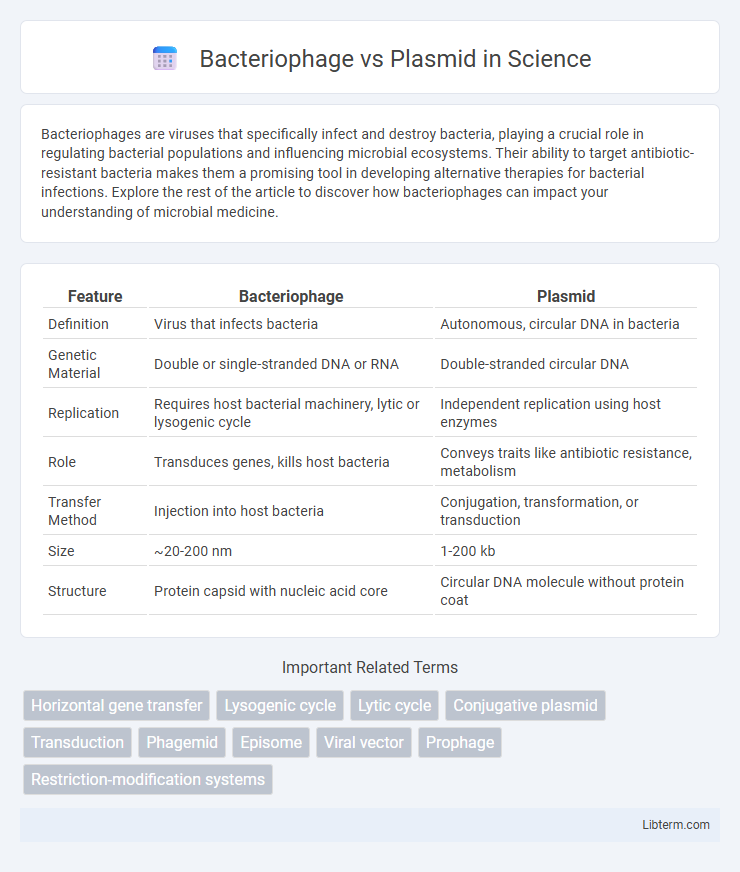Bacteriophages are viruses that specifically infect and destroy bacteria, playing a crucial role in regulating bacterial populations and influencing microbial ecosystems. Their ability to target antibiotic-resistant bacteria makes them a promising tool in developing alternative therapies for bacterial infections. Explore the rest of the article to discover how bacteriophages can impact your understanding of microbial medicine.
Table of Comparison
| Feature | Bacteriophage | Plasmid |
|---|---|---|
| Definition | Virus that infects bacteria | Autonomous, circular DNA in bacteria |
| Genetic Material | Double or single-stranded DNA or RNA | Double-stranded circular DNA |
| Replication | Requires host bacterial machinery, lytic or lysogenic cycle | Independent replication using host enzymes |
| Role | Transduces genes, kills host bacteria | Conveys traits like antibiotic resistance, metabolism |
| Transfer Method | Injection into host bacteria | Conjugation, transformation, or transduction |
| Size | ~20-200 nm | 1-200 kb |
| Structure | Protein capsid with nucleic acid core | Circular DNA molecule without protein coat |
Introduction to Bacteriophages and Plasmids
Bacteriophages are viruses that specifically infect bacteria, injecting their genetic material to hijack the bacterial machinery for replication. Plasmids are small, circular, double-stranded DNA molecules found within bacteria and other cells, capable of independent replication separate from chromosomal DNA. Both bacteriophages and plasmids play critical roles in horizontal gene transfer, influencing bacterial evolution and antibiotic resistance.
Structural Differences Between Bacteriophages and Plasmids
Bacteriophages possess a complex protein capsid enclosing their genetic material and often include tail structures for host cell attachment, whereas plasmids are small, circular, double-stranded DNA molecules lacking a protein coat. Bacteriophages typically have a defined morphology with head-tail or filamentous shapes, while plasmids exist freely in the cytoplasm of bacterial cells. These structural distinctions influence their replication mechanisms and modes of genetic transfer within microbial populations.
Replication Mechanisms: Bacteriophages vs Plasmids
Bacteriophages replicate through a lytic or lysogenic cycle, injecting their DNA into bacterial cells and hijacking the host's replication machinery to produce new viral particles. Plasmids replicate autonomously within bacterial hosts using theta or rolling-circle replication, independent of the bacterial chromosome replication. Unlike bacteriophages, plasmids ensure stable inheritance through controlled replication origins and partitioning systems during cell division.
Modes of Genetic Transfer in Bacteria
Bacteriophages transfer genetic material through transduction, where viral particles inadvertently package host DNA and introduce it into new bacterial cells, facilitating horizontal gene transfer. Plasmids primarily mediate genetic transfer via conjugation, involving direct cell-to-cell contact and the transfer of plasmid DNA through a pilus structure. Both mechanisms contribute significantly to bacterial genetic diversity and the spread of antibiotic resistance genes.
Roles in Horizontal Gene Transfer
Bacteriophages facilitate horizontal gene transfer primarily through transduction, where viral particles transfer bacterial DNA between cells, promoting genetic diversity and adaptability. Plasmids contribute via conjugation, enabling direct transfer of genetic material, such as antibiotic resistance genes, between bacteria. Both mechanisms significantly enhance microbial evolution by distributing beneficial traits across populations.
Applications in Genetic Engineering and Biotechnology
Bacteriophages serve as powerful vectors in genetic engineering by enabling targeted gene delivery and phage display techniques for protein engineering, while plasmids are widely used as cloning vectors to replicate and express recombinant DNA in bacterial hosts. In biotechnology, bacteriophages facilitate precise bacterial detection and control through phage therapy and biosensors, whereas plasmids enable production of recombinant proteins, gene editing via CRISPR systems, and metabolic pathway engineering. Both tools are integral for advancing molecular biology, synthetic biology, and therapeutic development due to their unique mechanisms of gene transfer and manipulation.
Impact on Antibiotic Resistance Spread
Bacteriophages contribute to the spread of antibiotic resistance by mediating horizontal gene transfer through transduction, enabling the movement of resistance genes between bacterial populations. Plasmids, as mobile genetic elements, play a critical role in disseminating antibiotic resistance by self-replicating and transferring resistance determinants via conjugation across diverse bacteria. The interplay between bacteriophage-mediated transduction and plasmid conjugation accelerates the evolution of multidrug-resistant bacterial strains, complicating infection control and antibiotic therapy.
Host Range and Specificity
Bacteriophages exhibit a narrow host range, infecting specific bacterial strains through recognition of surface receptors, which determines their high specificity. Plasmids possess a broader host range, capable of transferring genetic material across diverse bacterial species via conjugation, though compatibility depends on replication and partitioning systems. Understanding the distinct mechanisms governing host specificity in bacteriophages and plasmids informs applications in biotechnology and microbial ecology.
Evolutionary Significance of Bacteriophages and Plasmids
Bacteriophages drive bacterial evolution by facilitating horizontal gene transfer through transduction, promoting genetic diversity and adaptation to environmental pressures. Plasmids contribute to microbial evolution by enabling the exchange of genes, including antibiotic resistance and metabolic traits, thereby enhancing survival and ecological fitness. Both elements act as vectors of genetic innovation, shaping microbial populations and influencing evolutionary trajectories within bacterial communities.
Future Perspectives and Research Directions
Future research on bacteriophages and plasmids emphasizes their potential in targeted antimicrobial therapies and gene editing technologies. Advances in synthetic biology aim to engineer bacteriophages with enhanced specificity and efficacy against antibiotic-resistant bacteria, while plasmid-based systems are being optimized for safer, more efficient gene delivery in medical and agricultural applications. Emerging studies also explore the integration of bacteriophage and plasmid mechanisms to develop novel hybrid vectors for precise genetic manipulation and biocontrol strategies.
Bacteriophage Infographic

 libterm.com
libterm.com